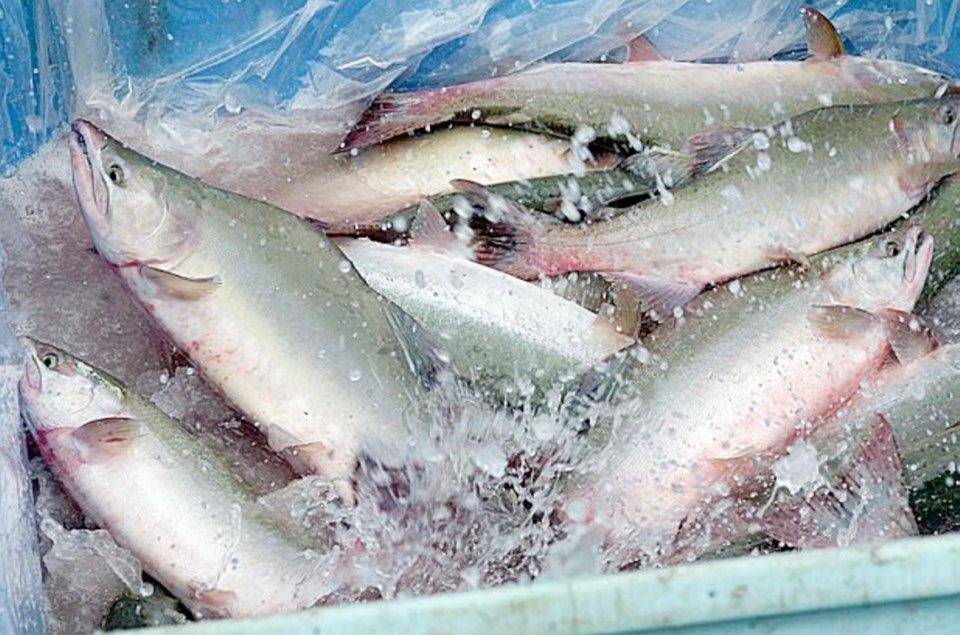Is it too soon to change B.C.’s iconic fish from the sockeye to the pink?
Probably, but we should be prepared nonetheless as evidence mounts that the phenomenal and persistent abundance of pink salmon is putting real pressure on other 91ԭ�� salmon and even sea birds that share the same food resources.
“We’ve certainly seen here on the South Coast big returns, in odd years, of the pink salmon,” said Brendan Connors, senior systems ecologist at ESSA Technologies and adjunct professor in the School of Resource and Environmental Management at Simon Fraser University.
“In general across the northeast 91ԭ��, we’ve seen dramatic increases in the amount of pink salmon and that has coincided with fairly broad patterns of decline in sockeye.”
Local observations bring that trend into sharp relief. Pink returns to the Fraser averaged about five million fish through the ’60s and ’70s, but began to take off in the ’80s before settling in at an average of 15 million returns in peak years during the past decade.
Meanwhile, the returns of sockeye to the Fraser River have been nothing short of chaotic. Abysmal return numbers in 2009 — a mere 1.5 million fish marked the low point in a decades-long general decline — sparked the $25-million Cohen Commission inquiry. That return coincided with the biggest return of pink salmon to all 91ԭ�� river systems recorded in at least a half century: 650 million fish.
But the pink salmon storyline has been very much lost amid the clamour over salmon farming.
Connors presented evidence to the Cohen Commission suggesting that of the four leading threats to the health of the Fraser River sockeye — net pen salmon farms, warming sea temperatures, the effects of large sockeye returns on freshwater food supply and predators, and competition with pink salmon — that rising pink abundance is the most influential factor.
There is consensus among fishery scientists that pink salmon are climate change winners, that rising ocean and river temperatures, ocean physics and plankton production have changed in their favour.
Pink returns peak every second year — odd years on the South Coast — so it is relatively easy to measure the impact of high- and low-return seasons on other fish and sea creatures. And study after study over the past decade shows that the impact is substantial.
Earlier this year, a study published by the Proceedings of the National Academy of Sciences by Alan Springer of the University of Alaska noted that pink salmon in the North 91ԭ�� and the Bering Sea have become “so numerous that they began to dominate other species of salmon for prey resources” and concluded that they were even outcompeting seabirds.
As early as 2003, Washington State fishery scientist Gregory Ruggerone noted that Bristol Bay sockeye were adversely affected by pink abundance and in a 2004 study concluded that hatchery chinook salmon released to Puget Sound in pink peak years were 59 per cent less likely to survive than those released in non-peak years.
Recent record-breaking Fraser sockeye returns — more than 28 million in 2010, with another strong return predicted for this summer — are insulated from the effect because they fall in even years, when pinks are less abundant.
Sockeye appear to suffer the most when they are forced to compete across the North 91ԭ�� in their spawning year with pinks from Russian river systems and pinks released by Alaskan hatcheries at a rate of up to 900 million a year.
“Pinks and sockeye are competing for a lot of the same food and for whatever reason, the pinks are more effective consumers of those resources,” Connors said. “They are also able to more quickly adapt to new foods as the seasonal buffet changes.”
Hatcheries pump about five billion salmon of all species into the 91ԭ�� each year. There are twice as many salmon in the 91ԭ�� Ocean now as there were in the 1950s, so many they are straining the ocean’s ability to support them.
Adding to the challenges faced by local stocks, sockeye don’t tend to do well when river temperatures rise, causing many fish to die of exhaustion before they can spawn. The Fraser River is now two degrees Celsius hotter than it was 50 years ago, often peaking above 20 C, the point at which sockeye begin to die in substantial numbers.
In Alaska’s Bristol Bay system, where wild sockeye runs remain healthy, river temperatures have risen, but not enough to stress the fish, said Connors.
Fraser and Bristol Bay sockeye are governed by the Goldilocks Principle. While the Fraser Basin is now too hot, especially for sockeye, Bristol Bay Basin — even though it is slightly warmer than before — is now just right.
The band of climatic conditions most favourable to sockeye has shifted northward with climate change to the detriment of the Fraser River sockeye, while pinks are able to thrive, said Ruggerone.
“The sockeye have struggled with warmer temperatures in the Fraser River, but the pinks have continued to increase in abundance,” he said. “Pinks don’t seem to be impacted.”



